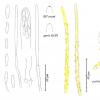
26-10-2012 07:21
Cvenkel MiranOn fraxinus excelsior?, no bark, covering big surf

26-10-2012 10:59
Gilbert MOYNEBonjour,Sur feuilles de Populus tremula de l'anné

24-10-2012 02:35
Renée LebeufBonjour à tous, J'aimerais vous soumettre cet as

26-10-2012 00:51
Esquivel-Rios EduardoHi AllThis Xylaria, found in decaying logs, has as

24-10-2012 05:33
Cvenkel MiranLoc.: Slovenia, on ground facing fraxinus excelsio

25-10-2012 17:21
Zykova MashaHi All!Few days ago I found a small disco(fruitbod

24-10-2012 21:19
 Chris Yeates
Chris Yeates
Bonsoir tousI am finding myself in the middle of a

21-10-2012 23:33
Esquivel-Rios EduardoHi All.Some time ago I report in this forum the An
Yellow, 'hairy', cup like id ?
Cvenkel Miran,
26-10-2012 07:21
photo
René Dougoud,
26-10-2012 08:11
Hans-Otto Baral,
26-10-2012 09:34

Re : Yellow, 'hairy', cup like id ?
Yes, I agree, though the microscopy should be tested. There is also a species with inamyloid ?asci and allantoid spores, and T. subsulphures is a variable, not easily definable species that seems to entirely lack sometimes the yellow colour.
Zotto
Zotto
Marja Pennanen,
26-10-2012 10:07
Re : Yellow, 'hairy', cup like id ?
Hi,
this may be like Trichopeziza sulphurea, which seems to loose the yellow color with age or at least cold.
Marja
this may be like Trichopeziza sulphurea, which seems to loose the yellow color with age or at least cold.
Marja
Cvenkel Miran,
26-10-2012 18:54
Re : Yellow, 'hairy', cup like id ?
Thanks for all tips.
